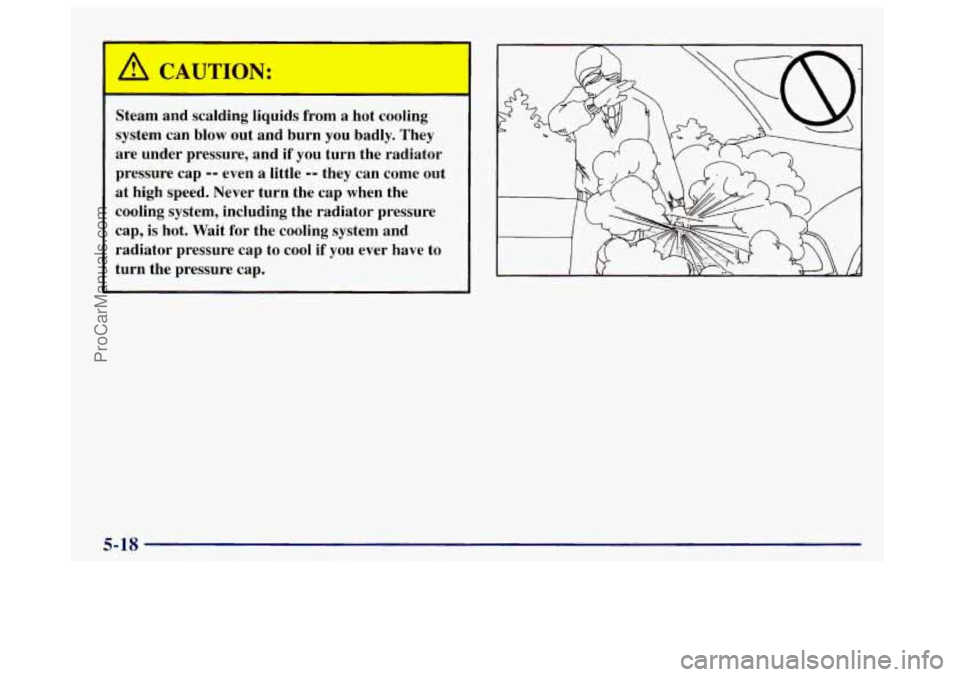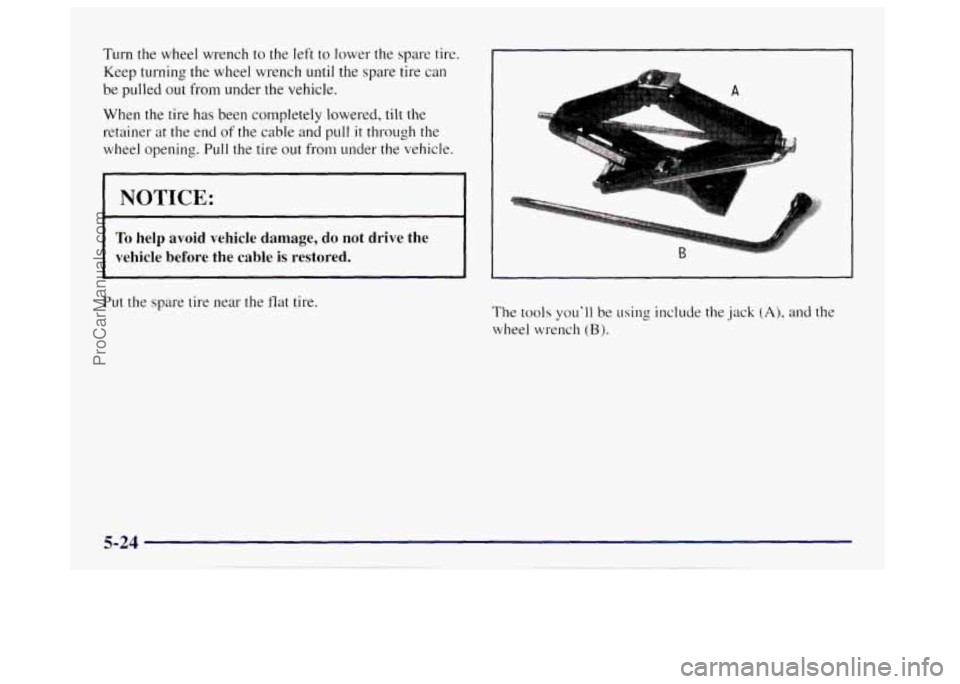OLDSMOBILE BRAVADA 1998 Owners Manual
Manufacturer: OLDSMOBILE, Model Year: 1998, Model line: BRAVADA, Model: OLDSMOBILE BRAVADA 1998Pages: 380, PDF Size: 19.2 MB
Page 221 of 380

When you decide it's safe to lift the hood, here's what
you'll see: If the coolant inside the coolant recovery tank is boiling,
don't do anything else until
it cools down.
A. Coolant Recovery Tank
B. Radiator Pressure Cap
C. Engine Fan
The coolant level should be at least up to the ADD mark.
If it isn't, you may have a leak in the radiator hoses,
heater hoses, radiator, water pump or somewhere else
in
the cooling system.
5-15
ProCarManuals.com
Page 222 of 380

U
Heater and radiator hoses, and other engine
parts, can be very hot. Don’t touch them.
If you
do, you can be burned.
Don’t run the engine if there is a leak.
If you run
the engine, it could lose all coolant. That could
cause an engine fire, and you could be burned.
Get any leak fixed before you drive the vehicle.
1 NOTICE:
Engine damage from running your engine
without coolant isn’t covered by your warranty.
If there seems to be no leak, start the engine again. See if
the engine cooling fan speed increases when idle speed is
doubled by pushing the accelerator pedal down. If it
doesn’t. your vehicle needs service. Turn off the engine.
How to Add Coolant to the Coolant
Recovery Tank
If you haven’t found a problem yet, but the coolant level
isn’t at the
ADD mark. add a 50/50 mixture of clecrn
\,L*crtet- (preferably distilled) and DEX-COOL@ engine
coolant
at the coolant recovery tank. (See “Engine
Coolant”
in the Index for more information.)
I A CAUTION:
Adding only plain water to your cooling system
can be dangerous. Plain water, or some other
liquid like alcohol, can boil before the proper
coolant mixture will. Your vehicle’s coolant
warning system
is set for the proper coolant
mixture. With plain water or the wrong mixture,
your engine could get
too hot but you wouldn’t
get the overheat warning. Your engine could
catch fire and you or others could be burned.
Use
a 50/50 mixture of clean water and
DEX-COOL@ coolant.
I
5-16
ProCarManuals.com
Page 223 of 380

NOTICE:
In cold weather, water can freeze and crack the
engine, radiator, heater core and other parts. Use the recommended coolant and the proper
coolant mixture.
I
You can be burned if you spill coolant on hot
engine parts. Coolant contains ethylene glycol
and it
will burn if the engine parts are hot
enough. Don't spill coolant on
a hot engine.
When the coolant in the coolant recovery tank is at the
ADD mark. start your vehicle.
If the overheat warning continues, there's one more
thing you can try.
You can add the proper coolant
mixture dire.ctly to the radiator, but
be sure the cooling
system
is cool before you do it.
5-17
ProCarManuals.com
Page 224 of 380

/A C,* UTION:
Steam and scalding liquids from a hot cooling
system can blow out and burn you badly. They
are under pressure, and
if you turn the radiator
pressure cap
-- even a little -- they can come out
at high speed. Never turn the cap when the
cooling system, including the radiator pressure
cap, is hot. Wait for the cooling system and
radiator pressure cap to cool if you ever have to
turn the pressure cap.
5-18
ProCarManuals.com
Page 225 of 380

How to Add Coolant to the Radiator
I
1. You can remove the radiator pressure cap when the
cooling system, including the radiator pressure cap
and upper radiator
hose, is no longer hot. Turn the
pressure cap slowly counterclockwise
until it first
stops. (Don't press down while turning the
pressure cap.)
If you hear a hiss, wait for that to stop. A hiss means
there is still
some pressure left.
p :. I
2. Then keep turning the pressure cap, but now push
down
as you turn it. Remove the pressure cap.
ProCarManuals.com
Page 226 of 380

3. Fill the radiator with the proper DEX-COOL@
coolant mixture, LIP to the base of the filler neck.
(See “Engine Coolant‘’
in the Index for more
information about the proper
coolant mixture.)
4. Then fill the coolant recovery tank to the ADD mark.
5. Put the cap back on the coolant recovery tank, but
leave the radiator pressure cap off’.
5-20
ProCarManuals.com
Page 227 of 380

6. Start the engine and let it run until you can feel the
upper radiator hose getting
hot. Watch out for the
engine cooling fan.
7. By this time, the coolant level inside the I-' d' lator
filler neck rnay be lower.
If the level is lower, add
more
of the proper DEX-COOL@ coolant mixture
through the filler neck until the level reaches the
base of the filler neck.
8. Then replace the pressure cap. At any time during
this procedure
if coolant begins to flow out of the
filler neck, reinstall the pressure
cap. Be sure the
arrows
on thti pressure cap line up like this.
5-2 1
ProCarManuals.com
Page 228 of 380

If a Tire Goes Flat
It’s unusual for a tire to “blow out” while you’re driving,
especially if
you maintain your tires properly. If air goes
out of
a tire, it’s much more likely to leak out slowly.
But if you should ever have
a “blowout,” here are a few
tips about what to expect and what to do:
If a front tire fails, the flat tire will create a drag that
pulls the vehicle toward that side. Take your foot off the
accelerator pedal and grip the steering wheel
firmly.
Steer to maintain lane position, and then gently brake to
a stop well out of the traffic lane.
A rear blowout, particularly on a curve, acts much like a
skid and may require the same correction you’d use in a
skid. In any rear blowout, remove your foot from the
accelerator pedal. Get the vehicle under control by
steering the way you want the vehicle to go. It may be
very bumpy and noisy, but you can still steer. Gently
brake to
a stop -- well off the road if possible.
If a tire goes flat, the next part shows how to use your
jacking equipment to change
a flat tire safely.
Changing a Flat Tire
If a tire goes flat, avoid further tire and wheel damage
by driving slowly to
a level place. Turn on your hazard
warning flashers.
Changing a tire can cause an injury. The vehicle
can slip off the jack and roll over you or other
people. You and they could be badly injured.
Find
a level place to change your tire. To help
prevent the vehicle from moving:
1. Set the parking brake firmly.
2. Put the shift lever in PARK (P).
3. nrn off the engine.
To be even more certain the vehicle won’t move,
you can put blocks at the front and rear of the
tire farthest away from the one being changed.
That would be the tire on the other side of the
vehicle, at the opposite end.
The following steps will tell you how to use the jack and
change
a tire.
5-22
ProCarManuals.com
Page 229 of 380

Removing the Spare Tire and Tools
The jacking equipment you’ll need is stored along the
driver’s rear wall. Your vehicle is also equipped with
work gloves and a plastic ground mat
to assist in the
changing
of a flat tire.
To remove the jack cover,
pull up on the latch(es) on
the cover, Remove the
wheel blocks, jack and
wheel wrench.
The spare tire
is stored under the vehicle.
NOTICE:
Never remove or restow a tire frodto a
stowage position under the vehicle while the
vehicle is supported
by a jack. Always tighten the
tire
fully against the underside of the vehicle
when restowing.
To remove the spare, insert
the chisel end
of the wheel
wrench, on an angle, into the hole
in the rear bumper.
Be sure the chisel end
of the
wheel wrench connects into
the hoist shaft.
ProCarManuals.com
Page 230 of 380

Turn the wheel wrench to the left to lower the spare tire.
Keep turning the wheel wrench until the spare tire can
be pulled out from under the vehicle.
Wflen the tire has been completely lowered,
tilt the
retainer at the end of the cable and
pull it through the
wheel opening.
Pull the tire out from under the vehicle.
~
(NOTICE: I
To help avoid vehicle damage, do not drive the
vehicle before the cable is restored.
I
F
Put the spare tire near the flat tire.
5-24
ProCarManuals.com